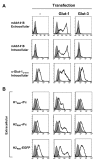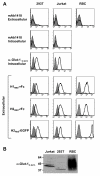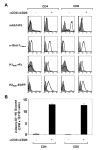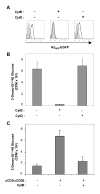Isolated receptor binding domains of HTLV-1 and HTLV-2 envelopes bind Glut-1 on activated CD4+ and CD8+ T cells
- PMID: 17504522
- PMCID: PMC1876471
- DOI: 10.1186/1742-4690-4-31
Isolated receptor binding domains of HTLV-1 and HTLV-2 envelopes bind Glut-1 on activated CD4+ and CD8+ T cells
Abstract
Background: We previously identified the glucose transporter Glut-1, a member of the multimembrane-spanning facilitative nutrient transporter family, as a receptor for both HTLV-1 and HTLV-2. However, a recent report concluded that Glut-1 cannot serve as a receptor for HTLV-1 on CD4 T cells: This was based mainly on their inability to detect Glut-1 on this lymphocyte subset using the commercial antibody mAb1418. It was therefore of significant interest to thoroughly assess Glut-1 expression on CD4 and CD8 T cells, and its association with HTLV-1 and -2 envelope binding.
Results: As previously reported, ectopic expression of Glut-1 but not Glut-3 resulted in significantly augmented binding of tagged proteins harboring the receptor binding domains of either HTLV-1 or HTLV-2 envelope glycoproteins (H1RBD or H2RBD). Using antibodies raised against the carboxy-terminal peptide of Glut-1, we found that Glut-1 expression was significantly increased in both CD4 and CD8 cells following TCR stimulation. Corresponding increases in the binding of H1RBD as well as H2RBD, not detected on quiescent T cells, were observed following TCR engagement. Furthermore, increased Glut-1 expression was accompanied by a massive augmentation in glucose uptake in TCR-stimulated CD4 and CD8 lymphocytes. Finally, we determined that the apparent contradictory results obtained by Takenouchi et al were due to their monitoring of Glut-1 with a mAb that does not bind cells expressing endogenous Glut-1, including human erythrocytes that harbor 300,000 copies per cell.
Conclusion: Transfection of Glut-1 directly correlates with the capacities of HTLV-1 and HTLV-2 envelope-derived ligands to bind cells. Moreover, Glut-1 is induced by TCR engagement, resulting in massive increases in glucose uptake and binding of HTLV-1 and -2 envelopes to both CD4 and CD8 T lymphocytes. Therefore, Glut-1 is a primary binding receptor for HTLV-1 and HTLV-2 envelopes on activated CD4 as well as CD8 lymphocytes.
Figures




References
-
- Kim FJ, Seiliez I, Denesvre C, Lavillette D, Cosset FL, Sitbon M. Definition of an amino-terminal domain of the human T-cell leukemia virus type 1 envelope surface unit that extends the fusogenic range of an ecotropic murine leukemia virus. J Biol Chem. 2000;275:23417–23420. doi: 10.1074/jbc.C901002199. - DOI - PubMed
Publication types
MeSH terms
Substances
LinkOut - more resources
Full Text Sources
Other Literature Sources
Research Materials
Miscellaneous

